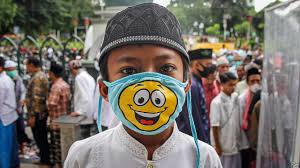Should people wear masks in public to slow the spread of SARS-COV-2?
人們應(yīng)該在公共場(chǎng)合戴口罩來(lái)減緩SARS-COV-2的傳播嗎?
The World Health Organisation (WHO) says don't bother. The British government agrees.
世界衛(wèi)生組織(WHO)說(shuō)不用這么麻煩。英國(guó)政府表示同意。
America's Centres for Disease Control and Prevention (CDC) initially discouraged it but by the beginning of April had reversed course.
美國(guó)疾病控制與預(yù)防中心(CDC)起初不鼓勵(lì),但到4月初,情況發(fā)生了逆轉(zhuǎn)。
In parts of Asia, including China, it is baked into public behaviour and encouraged by health agencies,
在包括中國(guó)在內(nèi)的亞洲部分地區(qū),即使沒(méi)有持續(xù)的公共衛(wèi)生危機(jī),
even when there is no ongoing public health crisis. The issue?
戴口罩也被納入公共行為并受到衛(wèi)生機(jī)構(gòu)的鼓勵(lì)。問(wèn)題呢?
Whether or not members of the public should wear face-masks in a bid to slow the spread of SARS-COV-2, the virus responsible for the covid-19 pandemic.
公眾是否應(yīng)該戴上口罩,以減緩SARS-COV-2的傳播。SARS-COV-2是造成covid-19全球流感大流行的病毒。
Understanding all the ways that SARS-COV-2 is transmitted is a matter of active scientific discussion.
理解SARS-COV-2的所有傳播途徑是一個(gè)積極的科學(xué)討論問(wèn)題。
In the main, though, the virus hitches a ride on droplets of mucus or saliva that come out of the respiratory tracts of infected individuals.
不過(guò),在大多數(shù)情況下,這種病毒只是附著在從感染者呼吸道流出的粘液或唾液飛沫上。
These may be expelled during normal breathing or, more commonly, as a cough that propels them a few metres into the air.
它們可能在正常呼吸時(shí)被排出體外,或者更常見(jiàn)的是,通過(guò)咳嗽將它們推向幾米高的空中。
Thus propelled, they may reach another person's eyes, mouth or nose directly, and go on to infect cells in that individual's airways.
因此,被彈出后,它們可能直接到達(dá)另一個(gè)人的眼睛、嘴巴或鼻子,然后繼續(xù)感染那個(gè)人呼吸道的細(xì)胞。
Or they may land on a surface, on which the virus particles they contain could survive for hours, or even days,
或者它們會(huì)落在一個(gè)表面,表面上的病毒顆粒可以存活幾個(gè)小時(shí),甚至幾天,
and from which those particles may eventually be transferred to others who touch the surface and then touch their own face or mouth.
并且這些顆粒最終可能會(huì)轉(zhuǎn)移給那些觸碰了這個(gè)表面,然后再觸碰到自己的面部和嘴部的人體內(nèi)。

There is no doubt that masks form a barrier to transmission, by stopping droplets passing from infected to uninfected people close by.
毫無(wú)疑問(wèn),口罩通過(guò)阻止飛沫從附近的感染者傳播到未感染者,并通過(guò)這種方式形成了一個(gè)傳播障礙。
The WHO recommends standard surgical masks as part of the personal protective equipment
WHO建議將標(biāo)準(zhǔn)醫(yī)用口罩做為個(gè)人防護(hù)設(shè)備的一部分,
to be worn by doctors and nurses who are caring for covid-19 patients in clinics and hospitals. The same goes for anyone caring for a patient at home.
讓在診所和醫(yī)院照顧covid-19病患的醫(yī)生和護(hù)士佩戴。同理適用于任何在家照顧病人的人。
In most instances this is good enough, according to a meta-analysis of four randomised controlled trials
根據(jù)加拿大麥克馬斯特大學(xué)的Mark Loeb本月在《流感》期刊上發(fā)表的
that was published this month in Influenza by Mark Loeb of McMaster University, in Canada.
對(duì)四項(xiàng)隨機(jī)對(duì)照試驗(yàn)的薈萃分析結(jié)果來(lái)看,在多數(shù)情況下,這樣做就足夠了。
Indeed, Dr Loeb found no significant differences between surgical masks and their more sophisticated cousins, N95 respirators,
Loeb博士發(fā)現(xiàn),在保護(hù)醫(yī)護(hù)人員免受飛沫傳播的病毒感染(包括包括由冠狀病毒引起的感染)方面,
when it came to protecting healthcare workers from viral infections transmitted by droplets—including those caused by coronaviruses.
醫(yī)用口罩和更加精制的N95口罩沒(méi)有明顯區(qū)別。
This suggests that N95 respirators (which are thicker, more rigid, and designed to form a close seal around the nose and mouth) should be reserved for riskier situations.
這表明N95口罩(更厚、更硬,能在鼻子和嘴巴周圍形成緊密的密封)應(yīng)該預(yù)留給風(fēng)險(xiǎn)更大的情況。
"N95" means they block at least 95% of particles smaller than 0.3 microns across.
N95意味著它們至少能阻擋95%直徑小于0.3微米的粒子。
They are, therefore, appropriate for situations when the threat comes from objects smaller than exhaled droplets— meaning less than about five microns across.
因此,它們適用于當(dāng)威脅來(lái)自比呼出的飛沫還小的物體時(shí),也就是直徑小于5微米的物體時(shí)的情況。
These particularly include times when doctors and nurses need to "intubate" a patient in an intensive care unit,
這些情況包括當(dāng)醫(yī)生和護(hù)士需要在重癥監(jiān)護(hù)病房給病人“插管”的時(shí)候,
by inserting the tube of a ventilator deep into that patient's trachea. Intubation is a forceful procedure, and it creates aerosol particles
即將呼吸機(jī)的管子深深插入病人的氣管中。插管是一種強(qiáng)制性的過(guò)程,在此過(guò)程中會(huì)產(chǎn)生氣溶膠顆粒
(ie, smaller than five microns) that may carry viruses much farther through the air than droplets can manage.
(如小于5微米),這些顆粒攜帶病毒在空氣中傳播的距離可能遠(yuǎn)遠(yuǎn)超過(guò)飛沫所能達(dá)到的距離。
Though it remains unclear whether SARS-COV-2 is transmitted via aerosols in this way,
雖然目前還不清楚SARS-COV-2是否以這種方式通過(guò)氣溶膠傳播,
those performing intubations should be cautious, says Lisa Brosseau, a respiratory protection and infectious-diseases scientist at the University of Illinois at Chicago.
但那些給病人插管的醫(yī)護(hù)應(yīng)該謹(jǐn)慎,芝加哥伊利諾伊大學(xué)的呼吸道防護(hù)和傳染病科學(xué)家Lisa Brosseau說(shuō)到。
譯文由可可原創(chuàng),僅供學(xué)習(xí)交流使用,未經(jīng)許可請(qǐng)勿轉(zhuǎn)載。












